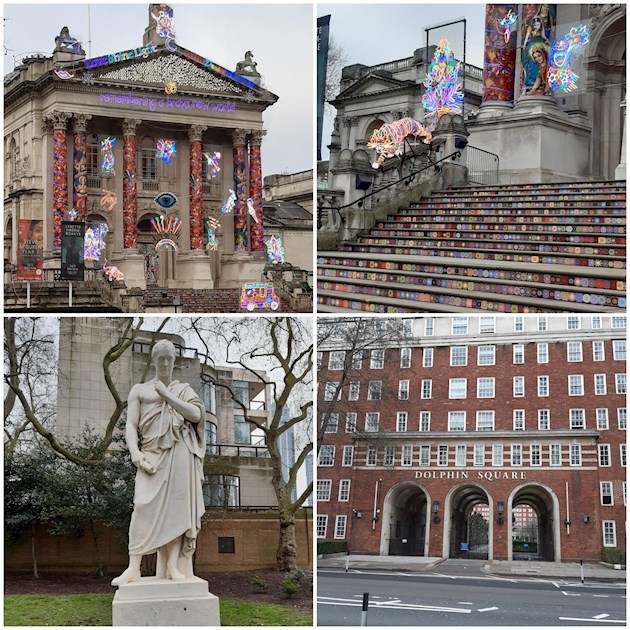Photo 1 and 2
The Tate Modern, looking beautiful, sadly closed at the moment
Photo 3
James husskisson monument.
William Huskisson PC was a British statesman, financier, and Member of Parliament for several constituencies, including Liverpool. He is commonly known as the world's first widely reported railway passenger casualty as he was run over and fatally wounded by Robert Stephenson's pioneering locomotive Rocket.
This is about his death and very long sorry and maybe boring 😊,
Huskisson had been diagnosed with strangury, a tender inflammation of the kidneys. He had undergone surgery, and had been advised by Royal doctor William George Maton to cancel all forthcoming appointments, which included the opening of the Liverpool and Manchester Railway. Huskisson chose to ignore this advice, believing the opening event too important to cancel. He rode down the line in a special train constructed for the Duke of Wellington and his guests and dignitaries, pulled by the locomotive Northumbrian which was driven by George Stephenson himself. This train was the only train on the south track; the other seven were in procession on the northern track. At Parkside railway station, near the midpoint of the line, the locomotives made a scheduled stop to take on water. Although the company had implicitly warned passengers to remain on the trains while this took place, around fifty of the dignitaries on board alighted when the Duke of Wellington's special train stopped. One of those who got off was Huskisson, who approached the Duke to take this opportunity to repair their relationship after a great falling out, which resulted in Huskisson leaving the government, and shook his hand.
At this time the train being pulled by Rocket approached on the other line. Rocket was being driven by Joseph Locke, George Stephenson's assistant and future eminent engineer in his own right. A shout went up, "An engine is approaching. Take care, gentlemen!" The other disembarked passengers either climbed back into their seats, or stepped over the northern line and completely out of the way. A third option was available, to stand with one's back to the stationary coaches, as there was a four-foot gap between the lines, and even though the Duke's private carriage was wider than a then-standard carriage, it would have still been possible to stand between the stationary train and the travelling train and remain safe. However, what unfolded was a calamitous series of events. Huskisson was known to be clumsy, and had endured a long list of problems from his regular trips and falls; he had twice broken his arm and never fully recovered the use of it. Added to this, he was only a few weeks post surgery and was present against his doctor's advice On realising his danger he panicked and made two attempts to cross the other line, but changed his mind and returned to the Duke's carriage. At this point Joseph Locke became aware and threw Rocket into reverse, but it would have taken 10 seconds to have any effect. Huskisson then panicked that the gap between the two trains was not big enough and so tried to clamber into the Duke's carriage. However, the carriage door had not been latched, and so it slowly swung open, leaving him hanging directly in the path of the oncoming Rocket, which hit the door, throwing Huskisson onto the tracks in front of the train. His leg was horrifically mangled by the locomotive.
A door was ripped from a railway building and Huskisson was placed on it, George Stephenson uncoupled the Northumbrian from the Duke's train and the mortally wounded MP was placed in a small carriage that had been occupied by a band, and with a small group of friends they set off to the vicarage at Eccles, and a doctor was called. A tourniquet had been applied, but it was not deemed possible to do a field amputation, so he was made comfortable with the assistance of the vicar's wife Emma Blackburne, whose "activity, sense & conduct" were mentioned in The Manchester Courier and The Times and remembered with gratitude by Huskisson's widow Emily who arrived at the vicarage from Liverpool. Huskisson was able to make his will and at nine in the evening, he finally succumbed to his injury.
The death and funeral of Huskisson led to wide reporting on the opening of the railway, for the first time making people around the world aware that cheap and rapid long-distance transport was now possible, if dangerous .
.
Photo 4
Dolphin Square apartments.
Dolphin Square is a block of private flats with some ground floor business units near the River Thames in Pimlico, Westminster, London, built between 1935 and 1937. Until the building of Highbury Square it was the most developed garden square in London built as private housing. At one time it was home to more than 70 MPs, and at least 10 Lords.
Some other notable occupants were
Bud Flanagan, Peter Finch, Princess Anne and you older folks will remember the Profumo affair girls Christine Keeler and Mandy ( no our Mandy 😊) Rice Davies.
Sorry so long.
